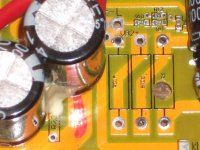philf
1 kW
Hahah... :lol:
Actually, in all seriousness, that's probably the right idea - a separate thread, I mean. THIS thread *should* stand alone, as the solution you are demonstrating is inexpensive and doable by anyone who can handle a soldering iron. When the final tweaks are done, it should be retained for future reference.
What ZapPat and I are thinking forces the need for a small PCB and soldering SMDs - something that will scare a lot of people away and muddy the waters, here.
Just a thought. I'm up to my ass in my real gig (and real life) right now, so how much I'll pursue the switcher over the next few days, I dunno. But I will make an effort to get an order in to DigiKey today so that I'll have something to play with, should I get some quality time on the weekend.
As a final comment on the simple switcher I have in one of the GM controllers - I made up a couple of the little PCBs when I made it, thinking they'd come in handy. Here's one (identical) to the one on the controller, only with a 5V regulator on it. The coil doesn't have to be that big - it's current rating is excessive - but I happened to have a few of the right value kicking around, so used 'em. This little board fit handily in the space on the GM controller freed up by removing 2 of the linear regulators and the associated caps/resistors (the 5V regulator was left in situ).

The thing doesn't really need the heat sink, either. It runs as cool as a cucumber...
Cheers!
Phil
Actually, in all seriousness, that's probably the right idea - a separate thread, I mean. THIS thread *should* stand alone, as the solution you are demonstrating is inexpensive and doable by anyone who can handle a soldering iron. When the final tweaks are done, it should be retained for future reference.
What ZapPat and I are thinking forces the need for a small PCB and soldering SMDs - something that will scare a lot of people away and muddy the waters, here.
Just a thought. I'm up to my ass in my real gig (and real life) right now, so how much I'll pursue the switcher over the next few days, I dunno. But I will make an effort to get an order in to DigiKey today so that I'll have something to play with, should I get some quality time on the weekend.
As a final comment on the simple switcher I have in one of the GM controllers - I made up a couple of the little PCBs when I made it, thinking they'd come in handy. Here's one (identical) to the one on the controller, only with a 5V regulator on it. The coil doesn't have to be that big - it's current rating is excessive - but I happened to have a few of the right value kicking around, so used 'em. This little board fit handily in the space on the GM controller freed up by removing 2 of the linear regulators and the associated caps/resistors (the 5V regulator was left in situ).

The thing doesn't really need the heat sink, either. It runs as cool as a cucumber...
Cheers!
Phil















